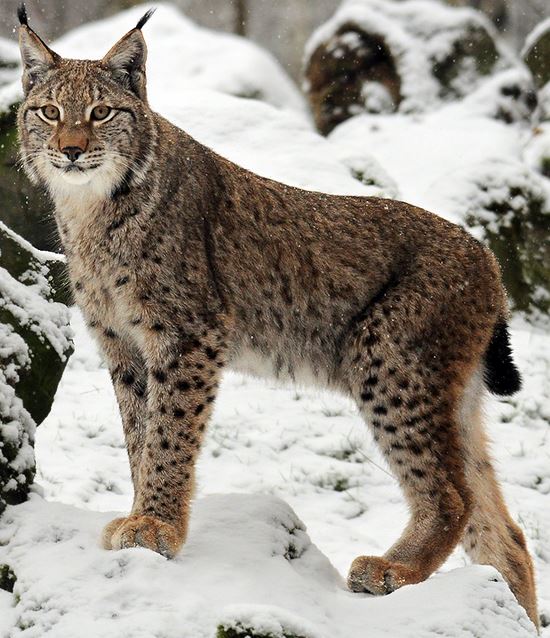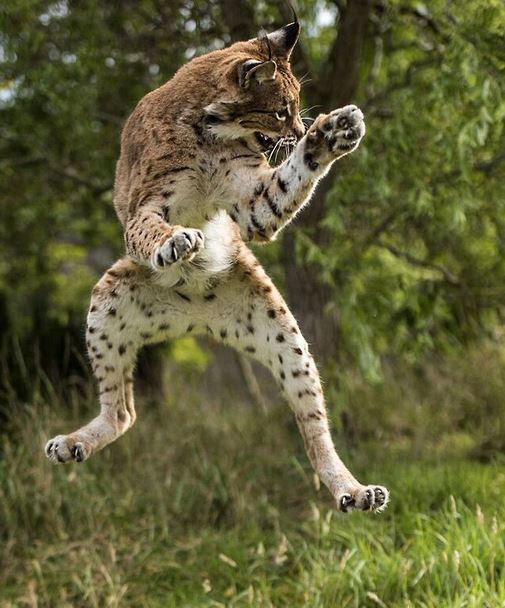The beautiful Eurasian Lynx could be living in the wild in British woodlands after being driven to extinction 1300 years ago if Lynx UK Trust’s scheme is approved. The charity first needs to carry out a national survey.
The Lynx UK Trust was formed by a group of experienced scientists and conservationists with specialisations in wild felines, field research, reintroductions and education. They have all worked on projects worldwide. Its ultimate aim is to bring wild lynx back to the UK.
The Trust aims to release Eurasian lynx into three privately-owned estates in Norfolk, Aberdeenshire and Cumbria. It is also calling on landowners in Wales to submit applications for consideration.

The lynx was driven out of the British Isles 1,300 years ago.
Dr. Paul O’Donoghue, who works at Chester University’s Department of Biological Sciences and is also the Trust’s Chief Scientific Advisor, said:
“The lynx is one of the most enigmatic, beautiful cats on the planet. The British countryside is dying and lynx will bring it back to life.”
Dr. O’Donoghue has managed a number of international projects, including working with some of the most endangered species in the world such as pygmy hippos and black rhinos. Closer to home, Chester University says he has made a huge leap towards conserving the critically endangered Scottish Wildcat.
The Eurasian Lynx, the third largest predator in Europe after the brown bear and wolf, is a medium-sized cat native to the forests of Europe, Siberia, Central and East Asia. It has very powerful legs and can jump 2 metres (6.5 feet) straight up into the air to strike at game bird.
It has large webbed and furred paws, making it an excellent swimmer. Due to its solitary nature, the lynx does not pose a threat to humans. It does not tend to roam into towns seeking food like foxes do.

With its powerful back legs, the Eurasian Lynx can jump more than 6 feet straight up into the air.
National Survey
The Lynx UK Trust has just launched a nationwide survey to get people’s opinions on reintroducing the lynx.
If all goes according to plan (if most people approve), it will then submit a formal reintroduction application with Natural England and Scottish Natural Heritage, which are authorised to grant licences for the release of wild animals.
The Trust would then release from four to six Eurasian lynx by the end of 2015 at each of the approved sites, which have plenty of woodland areas and are rich in deer, the animal’s favourite prey.
All the animals would be wearing GPS tracking collars so that the Trust can monitor them.

Bringing the wild Eurasian Lynx back to Britain would help control the deer population. (Photo: Lynx UK Trust)
There are more than one million wild deer in the UK, where it has no animal predator. According to the Trust, the lynx would help control deer numbers naturally.
Executive Director of the Deer Initiative, Peter Watson, an organisation set up in 1995 to promote the sustainable management of wild deer in England, said the reintroduction of lynx in Britain would help control deer populations “in a sustainable way”.
There is some resistance
Some livestock farmers are less keen on the idea. They wonder whether their animals would be attacked, as well as gamebirds.
However, in Poland and Romania, two countries where the Eurasian Lynx lives in the wild, attacks on livestock are very uncommon.
According to the Trust, there is a legal framework that structures potential reintroductions of animals to ensure successful outcomes. The framework concentrates on both the interests of the target animal and the general public.

TheLynx’ gestation lasts from 67 to 74 days. The mother has between 1 and 4 kittens.
To address the interests of the general public, the Trust has initiated a process of collecting public opinion.
The Lynx UK Trust is urging members of the public to help it get a clear picture of what people think about reintroducing these cats as part of a monitored and controlled trial. “Tell us what you think here,” it asks.
Scottish Wildlife Trust also wants the lynx back
The Scottish Wildlife Trust recently said it wanted to reintroduce the Eurasian Lynx to Scotland, a once native animal in the country, for both “moral and ecological reasons.”
Persecution and loss of habitat drove the animal out of Scotland 1300 years ago.
Jonny Hughes, CEO of the Scottish Wildlife Trust, said in December 2014:
“The Scottish Wildlife Trust has experience in bringing keystone species back to Scotland, having been a lead partner in the groundbreaking Scottish Beaver Trial, a trial reintroduction of the Eurasian beaver to Argyll. This was the first ever licensed reintroduction of a mammal species to the UK.”
“The five-year scientific monitoring period of the Scottish Beaver Trial has now come to an end and we await a ministerial decision on the future of beavers in Scotland. We believe that lynx should also be considered for reintroduction and in many ways could be a flagship for the restoration of native habitats, particularly woodlands into the future.”
“Although reintroductions of this nature are complex and must follow strict international guidelines, Scotland is leading the way with its new Scottish Code for Conservation Translocations launched by the Scottish Government earlier this year, through the work of the Scottish National Species Reintroduction Forum of which the Trust is a key member.”
The Eurasian lynx
Populations of the Eurasian Lynx (Lynx lynx), also called the Northern Lynx, Siberian Lynx, Russian Lynx, and Common Lynx, were either reduced or eliminated in western Europe several centuries ago. Over the past ten years, it has been gradually reintroduced in several areas.
The Eurasian Lynx is the largest of all the lynx species, reaching an adult height of between 60 and 75 cm (24 and 30 inches) at the shoulder, and a length of between 80 and 130 cm (31 and 51 inches). A German Shepherd dog’s height ranges from 60 to 65 cm.
Adult males weigh between 18 and 30 kg (40 and 66 lbs), and females between 8 and 21 kg (18 and 46 lbs).
Their favourite prey is roe and red deer, but they will also hunt reindeer, moose, rabbits, hares, squirrels, rodents, red foxes, birds, and wild boar.
Video – Eurasian Lynx
